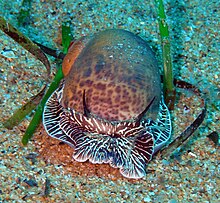Naticidae
| Naticidae Temporal range: late Triassic or early Jurassic – Recent |
|
|---|---|
 |
|
| A live individual of Naticarius hebraeus (Martyn, 1786), viewed from the front | |
| Scientific classification | |
| Kingdom: | Animalia |
| Phylum: | Mollusca |
| Class: | Gastropoda |
| (unranked): | clade Caenogastropoda clade Hypsogastropoda clade Littorinimorpha |
| Superfamily: |
Naticoidea Guilding, 1834 |
| Family: |
Naticidae Guilding, 1834 |
| Diversity | |
| 260–270 Recent species | |
Naticidae, common name the moon snails or necklace shells, is a family of minute to large-sized predatory sea snails, marine gastropod molluscs in the clade Littorinimorpha. The shells of the species in this family are mostly rather globular in shape.
Naticidae is the only family in the superfamily Naticoidea.
It has been estimated that worldwide there are about 260–270 Recent species of naticid snails. This group is assumed to have originated in the late Triassic or in the early Jurassic. Members of this family can be recognized by the shape of their shells, distinct appearance or by their predatory behavior.
Naticids are widely distributed and occur worldwide. The greatest diversity of both species and genera is found in tropical regions. Even so, naticid snails are also plentiful in temperate, Arctic and Antarctic waters.
Moon snails live on sandy substrates, at a great variety of depths depending on the species (from the intertidal zone to thousands of meters in depth). They are often seen ploughing along in the sand searching for prey.
Naticids are predatory, feeding mostly on bivalves. They will also attack almost any other shelled mollusk they encounter in the sand, such as scaphopods and other gastropods, including other moon snails. Additionally, Conuber sordidum was shown to prey on the soldier crab Mictyris longicarpus (Crustacea) by drilling predation. To catch soldier crabs, C. sordidum uses the same stereotyped behaviour as previously described for moon snails hunting shelled molluscan prey.
...
Wikipedia
